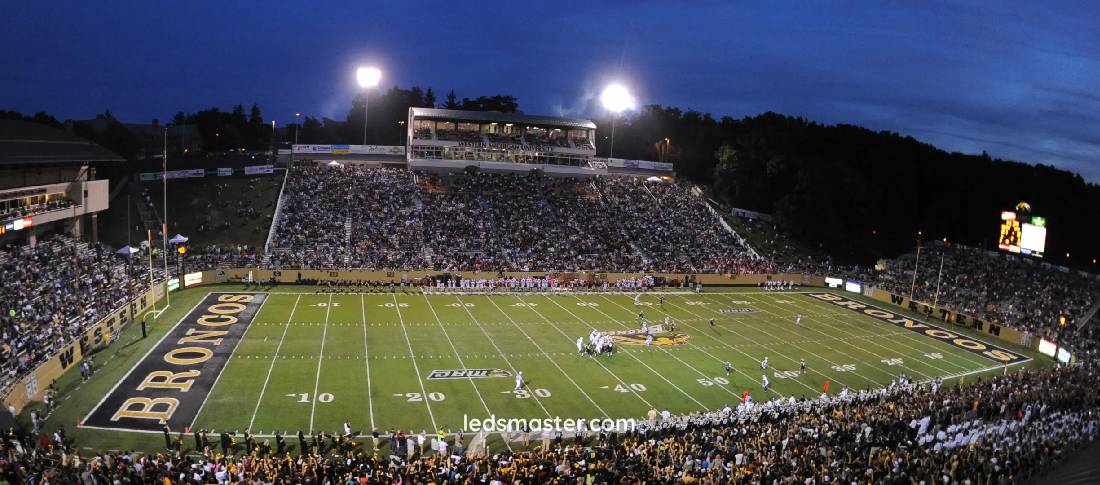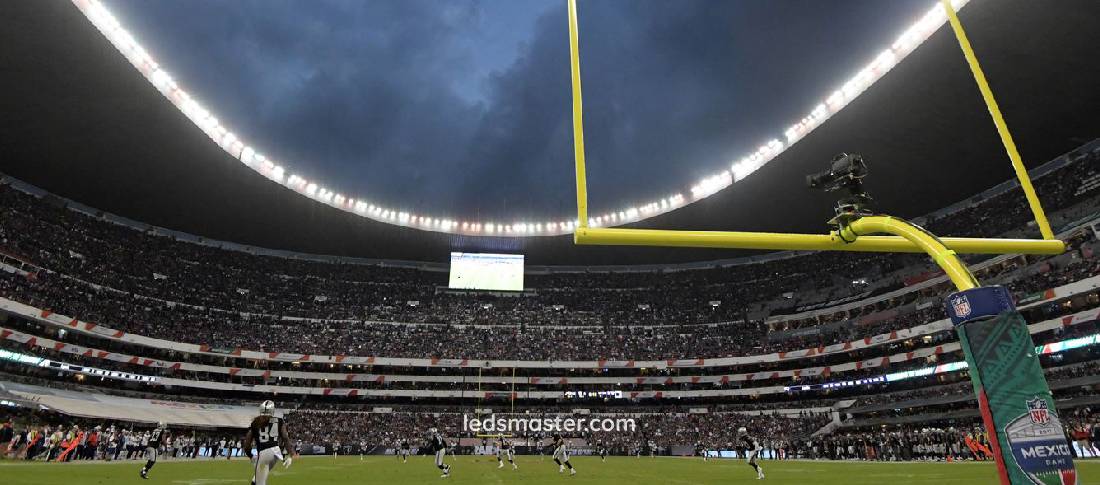When stadium lights become dim, it affects more than just the visibility of the game; it can compromise player performance, fan enjoyment, and overall safety. This article delves into the issues surrounding dim stadium lights and explores effective solutions, including the benefits of LED technology, the costs involved, and the impact on various stakeholders.
Table of Contents
ToggleThe Effects of Dim Stadium Lights

Players
Inadequate lighting can significantly hinder player performance by compromising visibility. Athletes rely on precise lighting to track fast-moving objects such as balls or pucks, and poor illumination can make it challenging to maintain focus. In sports that involve rapid movement, like football or soccer, players may struggle to gauge the speed and trajectory of the ball accurately, leading to mistakes in their play. Moreover, reduced visibility can increase the risk of injuries. For instance, players may not see obstacles or other players clearly, which can lead to collisions or falls. Clear and bright lighting is crucial not only for ensuring that athletes can see and react appropriately to the game’s demands but also for enabling them to perform at their best. Optimal lighting conditions help maintain focus, allowing players to execute their skills effectively and safely, thereby enhancing the overall quality of the game.
Fans
For fans, proper lighting is essential to an enjoyable and immersive viewing experience. Dim lights can diminish the excitement of the game by reducing the visibility of the action on the field or court. When lighting is insufficient, it can be difficult for spectators to follow the game, which detracts from their engagement and overall enjoyment. Fans expect to see every detail of the game clearly, and any reduction in visibility can lead to frustration and dissatisfaction. Bright, well-distributed lighting ensures that the action is visible from all angles, whether fans are seated in the stands or watching on large screens. Good lighting not only enhances the visual appeal of the event but also contributes to a more engaging and satisfying experience for everyone in the stadium.
Broadcast Quality
Television and media broadcasts depend heavily on high-quality lighting for clear and engaging visuals. Poor lighting can affect camera quality, resulting in grainy or underexposed images that fail to capture the full vibrancy of the event. This compromises the viewer’s experience by presenting a less dynamic and visually appealing broadcast. Dim lighting can lead to problems such as shadows, reduced contrast, and uneven illumination, which can detract from the clarity of the images. In turn, this can result in lower viewer engagement and satisfaction, as the audience may find it difficult to follow the action. High-quality lighting ensures that broadcasts are sharp, clear, and professionally presented, contributing to a more compelling and enjoyable viewing experience for audiences at home.
Stadium Functionality
Dim lighting can also affect the overall functionality of the stadium, particularly in emergency situations. Adequate lighting is crucial for ensuring that spectators and staff can navigate the venue safely and efficiently. In the event of an evacuation or other emergencies, insufficient lighting can create hazards, making it difficult for people to see exits, obstacles, or potential dangers. This can exacerbate safety risks and hinder the effective management of emergency situations. Proper lighting is essential for maintaining the stadium’s operational efficiency and ensuring the safety and well-being of everyone present. By investing in high-quality lighting, stadium management can help mitigate these risks and provide a safe environment for all stakeholders.

Common Causes of Dim Stadium Lights
Aging Lighting Equipment
One of the primary causes of dim stadium lights is the aging of lighting equipment. Traditional lighting systems, such as metal halide lamps, tend to lose brightness over time due to natural wear and tear. These lamps, which were once state-of-the-art, have a tendency to degrade as they are used, resulting in a noticeable reduction in light output. As metal halide lamps age, the internal components, such as the arc tube and reflector, can become less efficient at converting electrical energy into light. Additionally, the accumulation of dirt and dust on the fixtures can obstruct the light emitted, further diminishing the brightness of the stadium. Dust and debris can accumulate on the lamp surfaces and within the housing, creating a layer that reduces the amount of light that reaches the playing field and seating areas. Regular cleaning and maintenance are crucial to mitigating this issue, but over time, even well-maintained equipment will eventually need replacement to restore optimal lighting conditions.
Inefficiency of Older Technologies
Older lighting technologies, such as metal halide lamps, are inherently inefficient compared to more modern alternatives. These technologies have limited lifespans and their performance diminishes as they age. Metal halide lamps, for example, typically need to be replaced every 1,000 to 2,000 hours of use due to their declining efficiency. Despite regular maintenance, these systems struggle with reduced luminous output as they age. Even with frequent replacements, the overall light quality often remains below the standards of newer technologies. The inefficiency of older lighting systems is not just a matter of decreased brightness but also of increased energy consumption and maintenance costs. The need for constant upkeep and frequent bulb replacements adds to the operational costs and can lead to inconsistencies in lighting quality, impacting the stadium’s overall performance and the experience of players and fans.
Electrical Issues
Electrical issues can also contribute significantly to dim lighting in stadiums. Problems with wiring, circuit breakers, or connections can disrupt the flow of electricity to the lighting fixtures, leading to reduced illumination. Faulty wiring or loose connections can cause intermittent failures or voltage drops, which can diminish the effectiveness of the lighting system. Circuit breakers that are malfunctioning or overloaded may not provide consistent power, leading to dim or flickering lights. Diagnosing and addressing these electrical issues is crucial for restoring proper lighting. Electrical faults can be complex and may require the expertise of a licensed electrician to ensure that the repairs are carried out safely and effectively. Regular inspections and timely repairs of electrical components are essential for maintaining the integrity of the lighting system and ensuring consistent brightness throughout the stadium.
Effective Solutions for Dim Stadium Lights
Switching to LED Lighting
Energy Efficiency
LED lighting represents a significant advancement in energy efficiency compared to traditional metal halide lamps. Metal halide lamps are known for their high power consumption, which leads to substantial electricity bills, especially in large venues like stadiums where lighting systems are extensive. In contrast, LED lights consume significantly less power while providing equivalent or superior illumination. This reduction in energy usage translates directly into lower operational costs and a reduced environmental footprint. For stadiums, which often operate large lighting arrays for both night games and events, the cost savings from switching to LEDs can be considerable. Additionally, LEDs produce less heat than metal halide lamps, further contributing to their efficiency and reducing the load on cooling systems.
Longevity
The longevity of LED lights is another key advantage over traditional lighting technologies. Metal halide lamps typically need replacement every 1,000 to 2,000 hours of use due to their decreasing efficiency and lifespan. In contrast, LED lights boast an operational life of up to 50,000 hours or more. This extended lifespan greatly reduces the frequency of replacements, thereby lowering both the direct costs of purchasing new bulbs and the indirect costs associated with labor for installation. The longer operational life of LEDs also minimizes downtime and disruption, ensuring that the stadium remains brightly lit with fewer interruptions. This longevity is particularly beneficial for stadiums, where maintaining consistent lighting is crucial for player performance and fan experience.
Consistent Brightness
One of the significant benefits of LED lighting is its ability to maintain consistent brightness over time. Unlike traditional lighting systems that gradually dim as they age, LEDs are designed to deliver steady illumination throughout their operational life. This consistency is vital for ensuring that the stadium remains well-lit for every event, regardless of the number of hours the lights have been in use. Consistent brightness enhances visibility for players, reducing the likelihood of errors and injuries due to inadequate lighting. For spectators, it ensures a clear and enjoyable viewing experience, contributing to overall satisfaction with the event. The ability of LEDs to maintain their brightness also means that stadiums do not experience the gradual decline in light quality that can occur with older technologies.
Adjustable Color Temperature
LEDs offer remarkable flexibility in terms of color temperature, which allows stadiums to tailor the lighting to specific needs and preferences. Color temperature refers to the warmth or coolness of the light emitted, and it can significantly impact the atmosphere and functionality of the lighting. For example, stadiums can adjust the color temperature to create a vibrant, high-energy environment during key moments of an event, or opt for a cooler tone for other occasions. This adaptability is beneficial for accommodating different types of events and times of day. By customizing the lighting conditions, stadiums can enhance the visual appeal of the venue and improve the overall experience for both players and spectators. The flexibility provided by LEDs ensures that the lighting can be optimized for various scenarios, enhancing the stadium’s versatility and functionality.
Regular Cleaning and Maintenance
Cleaning
Routine cleaning is essential for maintaining stadium lights in optimal condition. Over time, dirt and debris accumulate on lighting fixtures, obstructing the light output and reducing overall brightness. This accumulation of grime can cause significant drops in illumination levels, affecting both the visual quality of the game and the safety of the venue. Regular cleaning helps to prevent this buildup and ensures that the lights remain bright and effective. By keeping fixtures clean, stadiums can maintain higher levels of illumination and extend the operational lifespan of their lighting equipment. This not only enhances the visibility for players and spectators but also reduces the need for frequent replacements, ultimately saving on maintenance costs.
Inspections
In addition to cleaning, regular inspections are critical for identifying and addressing potential issues with stadium lighting. These inspections help to detect signs of wear and tear, electrical problems, or other issues that could affect the performance of the lighting system. Regular checks ensure that any emerging problems are addressed promptly before they lead to more significant deterioration or outages. For example, inspections can reveal issues such as faulty wiring, deteriorating components, or inadequate electrical connections, allowing for timely repairs. Proactive maintenance through routine inspections helps to ensure that the lighting system remains effective and reliable, supporting a safe and enjoyable experience for everyone at the stadium.
Costs of Fixing Dim Stadium Lights
LED Lighting Replacement Costs
Replacing traditional lighting systems with LEDs involves a considerable initial investment. The cost of new LED fixtures can range from $200 to $1,000 per fixture, depending on the type and specifications required for a stadium. Additionally, installation costs can add between $5,000 and $15,000 or more, depending on the complexity of the setup and the number of fixtures being installed. While the upfront costs can be substantial, the long-term savings are significant. LEDs are highly energy-efficient, consuming up to 50% less power than traditional metal halide lamps. This reduction in energy consumption can lead to annual savings on electricity bills, often amounting to tens of thousands of dollars for large stadiums. Furthermore, LEDs require less frequent maintenance and replacements, which further contributes to long-term cost savings.
Upgrading Fixtures Costs
Upgrading existing fixtures with LED retrofit kits offers a more budget-friendly alternative to a full lighting system replacement. Retrofit kits can cost between $100 and $500 per fixture, depending on the compatibility with existing equipment and the complexity of the installation. The cost of retrofitting also includes installation, which can vary based on the number of fixtures and the extent of modifications required. This option is generally less expensive than a full replacement and allows for the continued use of existing lighting infrastructure. By choosing retrofitting, stadiums can achieve improved energy efficiency and performance without the higher costs associated with installing an entirely new lighting system.
Cleaning and Maintenance Costs
Routine cleaning and maintenance of stadium lighting systems are relatively low-cost compared to replacement or upgrading options. Cleaning services, which include the removal of dirt and debris from fixtures, generally cost between $200 and $1,000 per service, depending on the size of the stadium and the number of fixtures. Regular maintenance, such as checking for wear and tear and ensuring proper functioning, may add another $500 to $2,000 annually. Regular upkeep helps to maintain optimal lighting performance and prevents the need for more extensive and costly repairs or replacements.
Conclusion
Proper lighting is essential for maintaining the quality of stadium events, affecting player performance, fan enjoyment, and overall safety. Dim lights can compromise visibility and reduce the excitement of the game. Upgrading to LED lighting, despite its initial cost, offers significant benefits including energy efficiency, longevity, and consistent brightness. Routine cleaning and maintenance, while relatively inexpensive, are crucial for keeping lights in optimal condition. Investing in modern lighting solutions and regular upkeep ensures a better experience for players, fans, and all involved, making it a valuable investment for any stadium.

